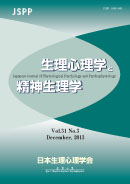All issues

Volume 31 (2013)
- Issue 3 Pages 181-
- Issue 2 Pages 53-
- Issue 1 Pages 1-
Volume 31, Issue 3
Displaying 1-3 of 3 articles from this issue
- |<
- <
- 1
- >
- >|
-
Sae NAKAGAWA, Naoto SUZUKI2013Volume 31Issue 3 Pages 181-191
Published: December 31, 2013
Released on J-STAGE: October 29, 2014
Advance online publication: March 04, 2014JOURNAL FREE ACCESSThe purpose of this study was to investigate the effect of a difference in subjective emotions and expressions, which was produced by intentionally smiling when experiencing a negative emotion, on cardiovascular responses. Forty two participants were shown two short films. They were divided into three groups; the unpleasant group was shown two disturbing films, the pleasant group was shown two happiness-inducing films. The neutral group was shown two neutral films. The participants were asked to intentionally smile while watching one of the two films (smile condition), and to have a normal expression while viewing the other (natural condition). We measured cardiovascular parameters while the participants watched the films and after they had finished watching them. We found that in smile condition, both the pleasant and unpleasant groups showed increased blood pressure; however, heart rate increased in the pleasant group, but decreased in the unpleasant group. The cardiovascular response for the unpleasant group resembled as an indication of maladaptive cardiovascular responding. Our results suggest that difference in subjective emotions and expressions may cause maladaptive physiological responses.View full abstractDownload PDF (697K)
-
Hiroki MORIYA, Jun TAKEICHI, Hiroshi NITTONO2013Volume 31Issue 3 Pages 193-201
Published: December 31, 2013
Released on J-STAGE: October 29, 2014
Advance online publication: December 10, 2013JOURNAL FREE ACCESSPositive moods are thought to promote the activation of semantic representation. Although recent studies have shown that the effects of mood on cognitive processes are influenced by mood arousal, it has thus far been unclear whether high- and low-arousal positive moods differently influence the lexical decision process. In this study, 24 university students performed a lexical decision task under high-arousal positive, low-arousal positive, and neutral moods, which were induced by sound clips. The amplitudes of the N400 elicited by word and pseudoword stimuli were greater under high-arousal positive moods than under neutral moods. The differences between low-arousal positive and neutral moods were not significant. These results suggest that a certain level of mood arousal is required for positive mood to promote semantic processing.View full abstractDownload PDF (593K)
-
Kenji YAMAGUCHI, Yoshio SAKURAI2013Volume 31Issue 3 Pages 203-212
Published: December 31, 2013
Released on J-STAGE: October 29, 2014
Advance online publication: February 10, 2014JOURNAL FREE ACCESSThis article briefly introduces methods of real-time control of operant box and data logging for behavioral experiments using the Arduino microcontroller. The Arduino microcontroller is low-cost and easy-operated hardware and has sufficient property for various behavioral experiments for neuroscience. This article explains what is the Arduino microcontroller and how to use it as a digital I/O controller. In addition, we introduce a technique for behavioral data logging using the Arduino microcontroller. The technique has some advantages over other logging techniques that use external memory storage devices. Finally, we introduce a method of our study as an example of behavioral neuroscience experiments using the Arduino microcontroller.View full abstractDownload PDF (8157K)
- |<
- <
- 1
- >
- >|